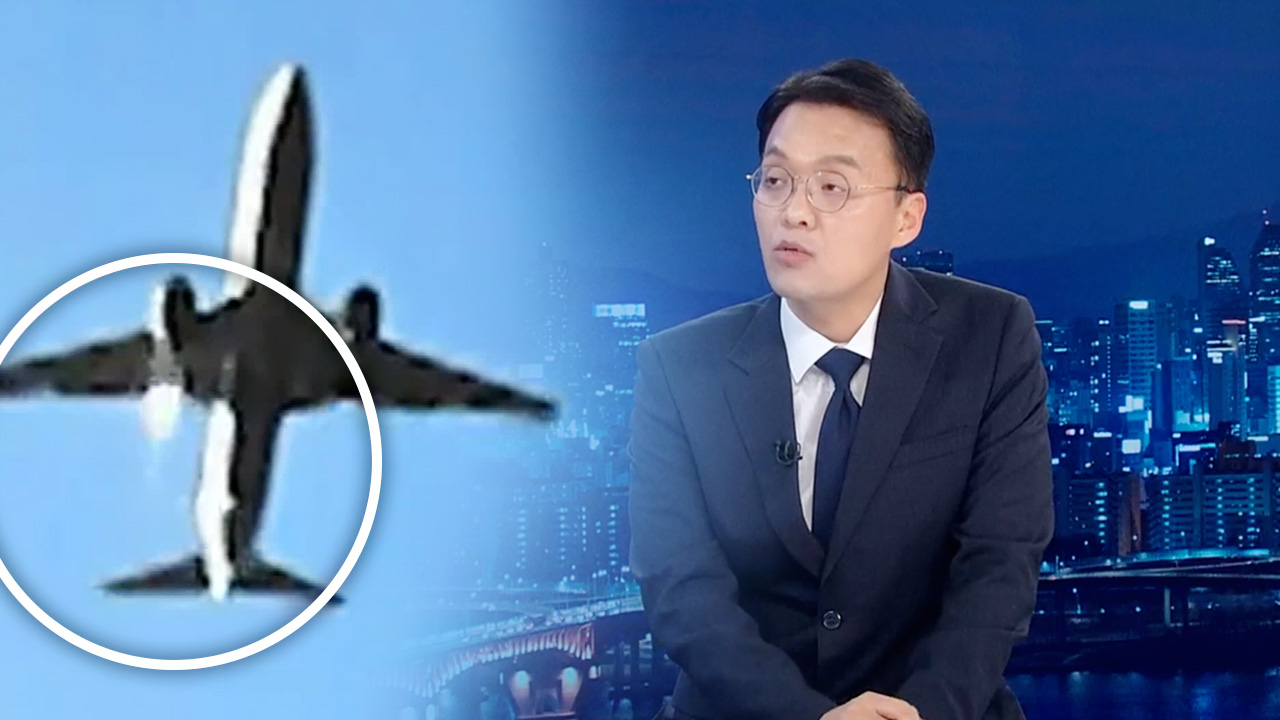What has and has not been confirmed about the Jeju Air passenger plane disaster
입력 2024.12.30 (02:14)
읽어주기 기능은 크롬기반의
브라우저에서만 사용하실 수 있습니다.
[Anchor]
Yes, let's go deeper with reporter Kim Jun-beom.
It is an aircraft accident, but the loss of life is just too great.
What could be the reason?
[Reporter]
The probability of survival in an aircraft accident is low, but if we look back at the process of the disaster, there were 'at least three' major impacts.
During the belly landing, there was the first 'impact' when attempting to brake on the runway, then the second 'impact' with the airport's outer wall, and finally an 'explosion'.
Impact, another impact, and then an explosion….
It seems that this chain of impacts led to the result of 'mostly fatalities'.
[Anchor]
Many of the bodies were found outside the aircraft fuselage, right?
[Reporter]
Yes, it was a short time, but let's break it down by the moments of impact.
As you can see, when the fuselage began to land, the aircraft appeared relatively intact.
Hypothetically, if the braking had been successful, there might have been more survivors.
However, it hit the outer wall and exploded, and the fuselage was shattered.
Given the emergency situation, all passengers would have been wearing their seatbelts, but it seems there was no way to withstand that level of impact.
[Anchor]
Didn't the fire after the explosion also increase the loss of life?
[Reporter]
We cannot rule out that possibility.
According to records, it took 43 minutes for the initial response.
It wasn't just the aviation fuel that burned; the aircraft fuselage, metal, and plastic also burned, likely producing a lot of toxic gas.
There may have been cases where people died not from the impact but from the fire.
Of course, this is a possibility, and confirmation of the cause of death through autopsies is necessary.
[Anchor]
Let's also look at the cause of the accident.
There is speculation that the aircraft collided with birds, and it seems that the landing gear did not operate properly.
What could be the connection between these two?
[Reporter]
It seems almost certain that the engine malfunctioned due to the bird strike, based on the statements of surviving crew members and footage from the time of the accident.
The failure of the landing gear to deploy is also clear from the footage.
However, it is still unclear why the landing gear did not deploy.
Whether the engine failure caused issues with the wheel drive system, or if the captain or co-pilot failed to deploy the landing gear during manual operation, that causal relationship has not yet been confirmed.
This is something that needs to be investigated.
[Anchor]
I heard that this passenger aircraft returned shortly after it departed for Beijing, recently.
Is there any connection to this accident?
[Reporter]
So, that part was captured during the reporting process and I checked. The aircraft involved in the accident, HL8088, did return to Incheon on its way to Beijing two days prior.
However, the reason for that return was reported differently by the Ministry of Land, Infrastructure and Transport as passenger disturbance, while Jeju Air cited an emergency situation. Regardless, the return two days prior was due to a human incident, not a material incident, and it is not directly connected to this accident.
[Anchor]
As mentioned in previous reports, how can we view the relationship between the number of flights and the accident?
[Reporter]
According to experts, if the operating time before the accident exceeds a certain number of hours, it is problematic, but if it is below that, it is not, and there is no absolute standard for this.
What is more important is whether there were any malfunctions or issues with the aircraft and what kind of maintenance it received; this information has more weight. However, the recent malfunction and maintenance history of the accident-incurred aircraft has not yet been confirmed.
In particular, it is important to know if there were any issues or maintenance related to the engine output and landing gear drive that were problematic today, and if there were, the fact that it had been on many flights recently could be one of the cumulative reasons.
[Anchor]
The runway at Muan Airport is shorter than those at Incheon and Gimpo airports.
How should we view this aspect?
[Reporter]
The runway at Muan Airport is 2,800 meters.
It is slightly longer than those at Cheongju or Daegu airports, but it is indeed shorter than those at Incheon or Gimpo airports. However, it is difficult to say that the runway length itself caused the accident.
However, as you have seen repeatedly in the footage, the damage increased as it passed the end of the runway and collided with the outer wall, leading to an explosion.
If the runway had been a bit longer, it might not have collided with the outer wall.
In that case, we could say that the damage might have been somewhat less.
[Anchor]
As you mentioned, it is indeed too early to speculate on the cause, and a thorough investigation should be conducted. What aspects will be contentious?
[Reporter]
The most urgent priority is reconstructing the events of the incident.
From the bird activity warning received at 8:54 to the first impact on the runway at 9:03, that 9-minute window is the golden time of this disaster.
It is crucial to reconstruct this event down to the second.
The last major incident involving a national airline was the Asiana Airlines accident at San Francisco Airport in July 2013, where the first report took 11 months.
It is important to focus investigative capabilities to shorten this period as much as possible.
[Anchor]
Yes, thank you for the information.
Yes, let's go deeper with reporter Kim Jun-beom.
It is an aircraft accident, but the loss of life is just too great.
What could be the reason?
[Reporter]
The probability of survival in an aircraft accident is low, but if we look back at the process of the disaster, there were 'at least three' major impacts.
During the belly landing, there was the first 'impact' when attempting to brake on the runway, then the second 'impact' with the airport's outer wall, and finally an 'explosion'.
Impact, another impact, and then an explosion….
It seems that this chain of impacts led to the result of 'mostly fatalities'.
[Anchor]
Many of the bodies were found outside the aircraft fuselage, right?
[Reporter]
Yes, it was a short time, but let's break it down by the moments of impact.
As you can see, when the fuselage began to land, the aircraft appeared relatively intact.
Hypothetically, if the braking had been successful, there might have been more survivors.
However, it hit the outer wall and exploded, and the fuselage was shattered.
Given the emergency situation, all passengers would have been wearing their seatbelts, but it seems there was no way to withstand that level of impact.
[Anchor]
Didn't the fire after the explosion also increase the loss of life?
[Reporter]
We cannot rule out that possibility.
According to records, it took 43 minutes for the initial response.
It wasn't just the aviation fuel that burned; the aircraft fuselage, metal, and plastic also burned, likely producing a lot of toxic gas.
There may have been cases where people died not from the impact but from the fire.
Of course, this is a possibility, and confirmation of the cause of death through autopsies is necessary.
[Anchor]
Let's also look at the cause of the accident.
There is speculation that the aircraft collided with birds, and it seems that the landing gear did not operate properly.
What could be the connection between these two?
[Reporter]
It seems almost certain that the engine malfunctioned due to the bird strike, based on the statements of surviving crew members and footage from the time of the accident.
The failure of the landing gear to deploy is also clear from the footage.
However, it is still unclear why the landing gear did not deploy.
Whether the engine failure caused issues with the wheel drive system, or if the captain or co-pilot failed to deploy the landing gear during manual operation, that causal relationship has not yet been confirmed.
This is something that needs to be investigated.
[Anchor]
I heard that this passenger aircraft returned shortly after it departed for Beijing, recently.
Is there any connection to this accident?
[Reporter]
So, that part was captured during the reporting process and I checked. The aircraft involved in the accident, HL8088, did return to Incheon on its way to Beijing two days prior.
However, the reason for that return was reported differently by the Ministry of Land, Infrastructure and Transport as passenger disturbance, while Jeju Air cited an emergency situation. Regardless, the return two days prior was due to a human incident, not a material incident, and it is not directly connected to this accident.
[Anchor]
As mentioned in previous reports, how can we view the relationship between the number of flights and the accident?
[Reporter]
According to experts, if the operating time before the accident exceeds a certain number of hours, it is problematic, but if it is below that, it is not, and there is no absolute standard for this.
What is more important is whether there were any malfunctions or issues with the aircraft and what kind of maintenance it received; this information has more weight. However, the recent malfunction and maintenance history of the accident-incurred aircraft has not yet been confirmed.
In particular, it is important to know if there were any issues or maintenance related to the engine output and landing gear drive that were problematic today, and if there were, the fact that it had been on many flights recently could be one of the cumulative reasons.
[Anchor]
The runway at Muan Airport is shorter than those at Incheon and Gimpo airports.
How should we view this aspect?
[Reporter]
The runway at Muan Airport is 2,800 meters.
It is slightly longer than those at Cheongju or Daegu airports, but it is indeed shorter than those at Incheon or Gimpo airports. However, it is difficult to say that the runway length itself caused the accident.
However, as you have seen repeatedly in the footage, the damage increased as it passed the end of the runway and collided with the outer wall, leading to an explosion.
If the runway had been a bit longer, it might not have collided with the outer wall.
In that case, we could say that the damage might have been somewhat less.
[Anchor]
As you mentioned, it is indeed too early to speculate on the cause, and a thorough investigation should be conducted. What aspects will be contentious?
[Reporter]
The most urgent priority is reconstructing the events of the incident.
From the bird activity warning received at 8:54 to the first impact on the runway at 9:03, that 9-minute window is the golden time of this disaster.
It is crucial to reconstruct this event down to the second.
The last major incident involving a national airline was the Asiana Airlines accident at San Francisco Airport in July 2013, where the first report took 11 months.
It is important to focus investigative capabilities to shorten this period as much as possible.
[Anchor]
Yes, thank you for the information.
■ 제보하기
▷ 카카오톡 : 'KBS제보' 검색, 채널 추가
▷ 전화 : 02-781-1234, 4444
▷ 이메일 : kbs1234@kbs.co.kr
▷ 유튜브, 네이버, 카카오에서도 KBS뉴스를 구독해주세요!
- What has and has not been confirmed about the Jeju Air passenger plane disaster
-
- 입력 2024-12-30 02:14:37

[Anchor]
Yes, let's go deeper with reporter Kim Jun-beom.
It is an aircraft accident, but the loss of life is just too great.
What could be the reason?
[Reporter]
The probability of survival in an aircraft accident is low, but if we look back at the process of the disaster, there were 'at least three' major impacts.
During the belly landing, there was the first 'impact' when attempting to brake on the runway, then the second 'impact' with the airport's outer wall, and finally an 'explosion'.
Impact, another impact, and then an explosion….
It seems that this chain of impacts led to the result of 'mostly fatalities'.
[Anchor]
Many of the bodies were found outside the aircraft fuselage, right?
[Reporter]
Yes, it was a short time, but let's break it down by the moments of impact.
As you can see, when the fuselage began to land, the aircraft appeared relatively intact.
Hypothetically, if the braking had been successful, there might have been more survivors.
However, it hit the outer wall and exploded, and the fuselage was shattered.
Given the emergency situation, all passengers would have been wearing their seatbelts, but it seems there was no way to withstand that level of impact.
[Anchor]
Didn't the fire after the explosion also increase the loss of life?
[Reporter]
We cannot rule out that possibility.
According to records, it took 43 minutes for the initial response.
It wasn't just the aviation fuel that burned; the aircraft fuselage, metal, and plastic also burned, likely producing a lot of toxic gas.
There may have been cases where people died not from the impact but from the fire.
Of course, this is a possibility, and confirmation of the cause of death through autopsies is necessary.
[Anchor]
Let's also look at the cause of the accident.
There is speculation that the aircraft collided with birds, and it seems that the landing gear did not operate properly.
What could be the connection between these two?
[Reporter]
It seems almost certain that the engine malfunctioned due to the bird strike, based on the statements of surviving crew members and footage from the time of the accident.
The failure of the landing gear to deploy is also clear from the footage.
However, it is still unclear why the landing gear did not deploy.
Whether the engine failure caused issues with the wheel drive system, or if the captain or co-pilot failed to deploy the landing gear during manual operation, that causal relationship has not yet been confirmed.
This is something that needs to be investigated.
[Anchor]
I heard that this passenger aircraft returned shortly after it departed for Beijing, recently.
Is there any connection to this accident?
[Reporter]
So, that part was captured during the reporting process and I checked. The aircraft involved in the accident, HL8088, did return to Incheon on its way to Beijing two days prior.
However, the reason for that return was reported differently by the Ministry of Land, Infrastructure and Transport as passenger disturbance, while Jeju Air cited an emergency situation. Regardless, the return two days prior was due to a human incident, not a material incident, and it is not directly connected to this accident.
[Anchor]
As mentioned in previous reports, how can we view the relationship between the number of flights and the accident?
[Reporter]
According to experts, if the operating time before the accident exceeds a certain number of hours, it is problematic, but if it is below that, it is not, and there is no absolute standard for this.
What is more important is whether there were any malfunctions or issues with the aircraft and what kind of maintenance it received; this information has more weight. However, the recent malfunction and maintenance history of the accident-incurred aircraft has not yet been confirmed.
In particular, it is important to know if there were any issues or maintenance related to the engine output and landing gear drive that were problematic today, and if there were, the fact that it had been on many flights recently could be one of the cumulative reasons.
[Anchor]
The runway at Muan Airport is shorter than those at Incheon and Gimpo airports.
How should we view this aspect?
[Reporter]
The runway at Muan Airport is 2,800 meters.
It is slightly longer than those at Cheongju or Daegu airports, but it is indeed shorter than those at Incheon or Gimpo airports. However, it is difficult to say that the runway length itself caused the accident.
However, as you have seen repeatedly in the footage, the damage increased as it passed the end of the runway and collided with the outer wall, leading to an explosion.
If the runway had been a bit longer, it might not have collided with the outer wall.
In that case, we could say that the damage might have been somewhat less.
[Anchor]
As you mentioned, it is indeed too early to speculate on the cause, and a thorough investigation should be conducted. What aspects will be contentious?
[Reporter]
The most urgent priority is reconstructing the events of the incident.
From the bird activity warning received at 8:54 to the first impact on the runway at 9:03, that 9-minute window is the golden time of this disaster.
It is crucial to reconstruct this event down to the second.
The last major incident involving a national airline was the Asiana Airlines accident at San Francisco Airport in July 2013, where the first report took 11 months.
It is important to focus investigative capabilities to shorten this period as much as possible.
[Anchor]
Yes, thank you for the information.
Yes, let's go deeper with reporter Kim Jun-beom.
It is an aircraft accident, but the loss of life is just too great.
What could be the reason?
[Reporter]
The probability of survival in an aircraft accident is low, but if we look back at the process of the disaster, there were 'at least three' major impacts.
During the belly landing, there was the first 'impact' when attempting to brake on the runway, then the second 'impact' with the airport's outer wall, and finally an 'explosion'.
Impact, another impact, and then an explosion….
It seems that this chain of impacts led to the result of 'mostly fatalities'.
[Anchor]
Many of the bodies were found outside the aircraft fuselage, right?
[Reporter]
Yes, it was a short time, but let's break it down by the moments of impact.
As you can see, when the fuselage began to land, the aircraft appeared relatively intact.
Hypothetically, if the braking had been successful, there might have been more survivors.
However, it hit the outer wall and exploded, and the fuselage was shattered.
Given the emergency situation, all passengers would have been wearing their seatbelts, but it seems there was no way to withstand that level of impact.
[Anchor]
Didn't the fire after the explosion also increase the loss of life?
[Reporter]
We cannot rule out that possibility.
According to records, it took 43 minutes for the initial response.
It wasn't just the aviation fuel that burned; the aircraft fuselage, metal, and plastic also burned, likely producing a lot of toxic gas.
There may have been cases where people died not from the impact but from the fire.
Of course, this is a possibility, and confirmation of the cause of death through autopsies is necessary.
[Anchor]
Let's also look at the cause of the accident.
There is speculation that the aircraft collided with birds, and it seems that the landing gear did not operate properly.
What could be the connection between these two?
[Reporter]
It seems almost certain that the engine malfunctioned due to the bird strike, based on the statements of surviving crew members and footage from the time of the accident.
The failure of the landing gear to deploy is also clear from the footage.
However, it is still unclear why the landing gear did not deploy.
Whether the engine failure caused issues with the wheel drive system, or if the captain or co-pilot failed to deploy the landing gear during manual operation, that causal relationship has not yet been confirmed.
This is something that needs to be investigated.
[Anchor]
I heard that this passenger aircraft returned shortly after it departed for Beijing, recently.
Is there any connection to this accident?
[Reporter]
So, that part was captured during the reporting process and I checked. The aircraft involved in the accident, HL8088, did return to Incheon on its way to Beijing two days prior.
However, the reason for that return was reported differently by the Ministry of Land, Infrastructure and Transport as passenger disturbance, while Jeju Air cited an emergency situation. Regardless, the return two days prior was due to a human incident, not a material incident, and it is not directly connected to this accident.
[Anchor]
As mentioned in previous reports, how can we view the relationship between the number of flights and the accident?
[Reporter]
According to experts, if the operating time before the accident exceeds a certain number of hours, it is problematic, but if it is below that, it is not, and there is no absolute standard for this.
What is more important is whether there were any malfunctions or issues with the aircraft and what kind of maintenance it received; this information has more weight. However, the recent malfunction and maintenance history of the accident-incurred aircraft has not yet been confirmed.
In particular, it is important to know if there were any issues or maintenance related to the engine output and landing gear drive that were problematic today, and if there were, the fact that it had been on many flights recently could be one of the cumulative reasons.
[Anchor]
The runway at Muan Airport is shorter than those at Incheon and Gimpo airports.
How should we view this aspect?
[Reporter]
The runway at Muan Airport is 2,800 meters.
It is slightly longer than those at Cheongju or Daegu airports, but it is indeed shorter than those at Incheon or Gimpo airports. However, it is difficult to say that the runway length itself caused the accident.
However, as you have seen repeatedly in the footage, the damage increased as it passed the end of the runway and collided with the outer wall, leading to an explosion.
If the runway had been a bit longer, it might not have collided with the outer wall.
In that case, we could say that the damage might have been somewhat less.
[Anchor]
As you mentioned, it is indeed too early to speculate on the cause, and a thorough investigation should be conducted. What aspects will be contentious?
[Reporter]
The most urgent priority is reconstructing the events of the incident.
From the bird activity warning received at 8:54 to the first impact on the runway at 9:03, that 9-minute window is the golden time of this disaster.
It is crucial to reconstruct this event down to the second.
The last major incident involving a national airline was the Asiana Airlines accident at San Francisco Airport in July 2013, where the first report took 11 months.
It is important to focus investigative capabilities to shorten this period as much as possible.
[Anchor]
Yes, thank you for the information.
-
-

김준범 기자 jbkim@kbs.co.kr
김준범 기자의 기사 모음
-
이 기사가 좋으셨다면
-
좋아요
0
-
응원해요
0
-
후속 원해요
0















이 기사에 대한 의견을 남겨주세요.